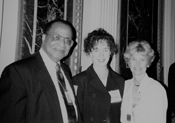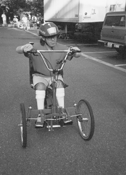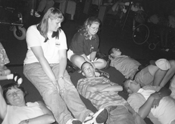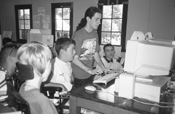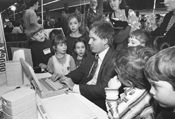DO-IT Phase I Scholars participated in a two-week, live-in summer study session on the University of Washington campus in Seattle, Washington. They learned about college life; explored science, engineering, mathematics, and technology; surfed the Internet; interacted with peers, staff, and mentors; and had fun. Below, Phase I Scholars share some of their experiences.
College Quirks
by DO-IT Scholars, Chris and Jennifer
During these past two weeks we have learned a great deal about college life, and have had fun doing it. We have learned how to interact with other people, be more familiar with area of the college campus, and the subtle little hints to college life. Interaction with people in a college setting is important. Interaction with a varied group of people helps to keep your social life interesting. You learn how to get along with complete strangers. This makes you a stronger person because you have to assert yourself and it gives you more confidence.
The University of Washington is bewildering to people who have never been there before. It is a huge campus and it is very easy to get lost. Being here has helped us prepare for the future, particularly when we want to attend and if we want to go to a big or small college. It also gives us an idea of how a college is laid out. Being here for these two weeks we picked up several little hints about college life. The first hint is to eat as little as possible, because the food sucks. The second hint to pick up is to always bring your key with you because you will get locked out. The third hint is to get enough sleep because you most likely will fall asleep during the lectures. The fourth and final hint about college life is to have fun.
DO-IT Scholar, Michael, enjoys a summer afternoon of biking at the Ski-For-All activity during the DO-IT Summer Study.
Earthquakes: Will the big one hit Seattle?
by DO-IT Scholars, Michael and Sharon
We learned about earthquakes during Summer Study '97. The theory of continental drift originated in 1912, when a geographer named Alfred Wegener noticed that many continental features fit together and in doing so, one major continent could be formed. The theory was further refined as the idea that the continents were the basic structures was discarded in favor of triangular objects called plates. As geological and fossil evidence poured in from around the world, the theory gained strength. Yet it was not well excepted because a model for plate movement did not exist. During the 1960's the theory of convection, wherein material from the mantle circulates upward and then falls, was proposed and the model for plate movement was created.
There are two different types of earthquakes--subduction and strike-slip. Subduction variety quakes are the worst type of earthquakes, occasionally reaching between 8 and 9 on the Richter Scale, the main scale of earthquake measurement, due to the immense stress that creates them. While strike-slips are more common and found a lot in California and elsewhere, they are far less devastating, averaging between 7.0 and 8.0. Strike-slip quakes occurs along faults, which are places where two plates slide past each other. History indicates that Seattle may soon have an earthquake which will be caused by subduction, which is when an oceanic plate slips or dives under a continental plate. So maybe Washington/Oregon will fall in the ocean instead of California, whereas California will move northward and eventually end up by Seattle.
Subduction quakes off the ocean shores of Washington and Oregon seem to come around every 200 years and one is due pretty soon!! So while California might get a big one, Washington and Oregon will get an even a bigger one.
Up, Up Away in the Atmosphere
by DO-IT Scholars, Laura and Keaton
Attention readers, this is a bulletin from the DO-IT Hurricane Information Center. We are currently tracking a severe weather system over the Gulf of Mexico with serious hurricane potential. At last check, tropical storm Charles had winds of fifty miles per hour. Barometric pressure inside the storm is dropping rapidly as the storm gathers power. It is highly likely that the storm will reach hurricane strength, with winds above seventy-five miles per hour, within the next eighteen hours.
Tropical storms form over warm waters and are upgraded to hurricanes when their winds exceed seventy-four miles per hour. These storms can have diameters hundreds of kilometers across. When they make landfall they can cause extreme damage. All residents in areas where one of these storms is predicted to hit should evacuate as soon as possible and take other safety precautions to protect their property. Those who are unable to or choose not to leave the area should seek shelter in a central room on the lowest floor of a stable building. Avoid staying in trailers or other light structures. All right, there isn't really a DO-IT Hurricane Information Center, but after a great presentation by Imke Durre, a doctorate student at the University of Washington and DO-IT Mentor, DO-IT Scholars got a close-up look at these fascinating storms. Did you know that these storms rotate in opposite directions depending on whether they are in the North or South hemisphere? These storms are pretty cool, but they can also be very costly. The presentation included footage of Hurricane Hugo, the most expensive storm on record.
We learned about the classification and naming of these monster storms. If the storm forms in the western Pacific or the Atlantic it is called a hurricane, but if it is in the eastern Pacific, it is called a typhoon. In the Indian ocean, they are known as tropical cyclones. A hurricane starts out as a tropical disturbance, which may progress to become a tropical depression if its winds exceed 20 knots. At this point the system is given a number. If the storm continues to gain strength, and the winds rise to above 39 knots, it becomes a tropical storm and is awarded a name. The names given the storms that occur in a given season go alphabetically and alternate between male and female names. Some storms finally attain the rank of hurricane. These are classified by their windspeed, with the highest level (5) being those extreme storms with winds above 150 miles per hour. These are extremely damaging and deadly. Most such storms' names are retired and not used again. Andrew and Hugo are two names that have been removed from the roster due to the power of the hurricanes they represented.
Part of this fun and informative presentation was a trip into the eye of a hurricane via the Internet. The URL for this great trip is hurricanehunters.com/. For even more net-info on hurricanes, check out covis1.atmos.uiuc.edu/guide/hurricanes. DO-IT in cyberspace!
Internet Scavenging
by DO-IT Scholars, Amanda and Justin
We are proud to introduce you to the best site on the Internet. The best search engine is Yahoo. The URL is www.yahoo.com. There is another search engine that works well. It is www.hotbot.com. There is a music sight which is for people who like midi. The sight is www.midi.com. Another good site is www.usatoday.com for people who enjoy reading the paper without having to pay for it. This site includes all the aspects of the paper. Many more sites exist on the Internet with sports (www.si.com/), news (www.cnn.com/) and for conversing between people there is chatrooms. One such chatroom is at Yahoo Chat. These chatrooms are interesting because you can meet many different people.
Advantages of Working Together in Sciences
by DO-IT Scholars, Stephen and Joshua
Students can have dramatic problems working within science labs. Some students more prone to these problems are students in wheelchairs, with hearing impairments, with visual difficulties, and with concealed disabilities. Most problems that affect them can be accommodated with very simple accommodations (e.g., sitting in the front of the class room, handouts to go along with overhead projectors, or lower or higher tables).
Learning disabilities, attention deficit disorder, hyperactivity, dyslexia, and other hidden disorders can make teachers uncomfortable, but sometimes the slightest accommodation can result in a great amount of change. Letting students sit in the front of the class, more interaction within the lectures, and more hands on activity with a wide variety of subjects can help keep the interest alive. Students with mobility impairments have specific needs just like everyone else. This includes having tables that can adjust to different heights, lab partners to help when fine motor skills are needed, and accessible entrances to the buildings where labs and classes are held.
Students with hearing impairments may have a hard time hearing sounds that are happening during the lab or they may miss the procedures given by teachers. Written procedures are helpful. If there is a lab that has to do with sounds that a deaf person cannot hear then it is helpful to have a visual indication to show that the sound has appeared or it has not appeared.
Students with vision impairments may have a hard time seeing what is happening or what the object of interest is doing. To answer that problem, it would be helpful if someone was telling them what was happening in the lab or a teacher could explain what will or should be happening in the lab. This way people who are blind and have low vision could be just as involved in the lab, with the verbal descriptions, as the people that can see.
Impressions of DO-IT
by DO-IT Scholars, Karyn and Andrew
Most people agreed that this year's DO-IT program was very good, but there was also a common feeling that many things could be improved. The activities were a good idea, but there needed to be more Scholar interaction. Some felt that it would have been nice if there were less lectures, and more interactive activities. The high-level discussions of how to use things like FTP, the Web, or PINE were very good. But some of the Internet-related discussions were lacking in-depth explanations of how the actual protocols work. We wish that the Search Engine synopsis were more comprehensive.
To conclude to this article we gathered several opinions of other DO-IT Phase I Scholars.
- "The idea [of DO-IT] is a good one, but like any other program in its beginning, major changes need to occur to make it better."
- "It is an excellent program, certainly one I can feel comfortable in."
Have a Heart!
by DO-IT Scholars, Minh and Veronica
One of the activities we did at Summer Study was the "Have a Heart" Lab. It was presented by Laura Clark. The purpose of the lab was to learn more about the structure of the heart. In the lab, we performed "heart surgery" on a sheep's heart. We learned not only the heart's structure and functions, but we also learned how different surgeries can correct many disorders. First we learned about the different functions of the heart. We then performed a bypass on the heart. We are sorry to say that our patients didn't survive. After this devastating experience, we decided to find out if a new valve might revive the heart. It did not. Since all hopes of saving the poor sheep were lost, we sliced the heart in half . Although the heart was definitely beyond repair, we learned a lot about how it worked. This lab was very helpful for people who want to go into the medical field. Heart surgery was one of the most fun and educational activities in Summer Study. It gave us a real hands-on learning experience and showed us one of the many applications of science.
Music on the Internet
by DO-IT Scholars, Shakethia and Ben
Are you tired of sitting at home without any music? Well, guess what? You can find it on the 'Net!! That's right. There is music on the Net. All you have to do is sit down at your computer and type a few words and there you have it. Now don't say they don't have your type of music because they have all kinds including R & B, reggae, pop, country, jazz, classical, and much more. You can even get videos to go along with the music, although the videos may be slow and shaky. "RealPlayer" from Progressive Networks, Inc., is a good program to download from the Internet for audio and or video clips. Just think about it! If you cannot get home from school or work to see your favorite video all you have to do is go to www.mtv.com and you can see the Top Twenty Countdown or even check up on your favorite MTV Show. If you like a local radio station you can go to their web site and listen to their music. And if you like a certain CD, you can visit your favorite CD retailer on the Web and order it. There are many possibilities, but it's up to your preference to choose what you like.
Good Software:
"RealPlayer" Progressive Networks, Inc.
https://realnetworks.com/
Good Web sites:
www.sony.com/en/
www.mtv.com
www.midi.com
